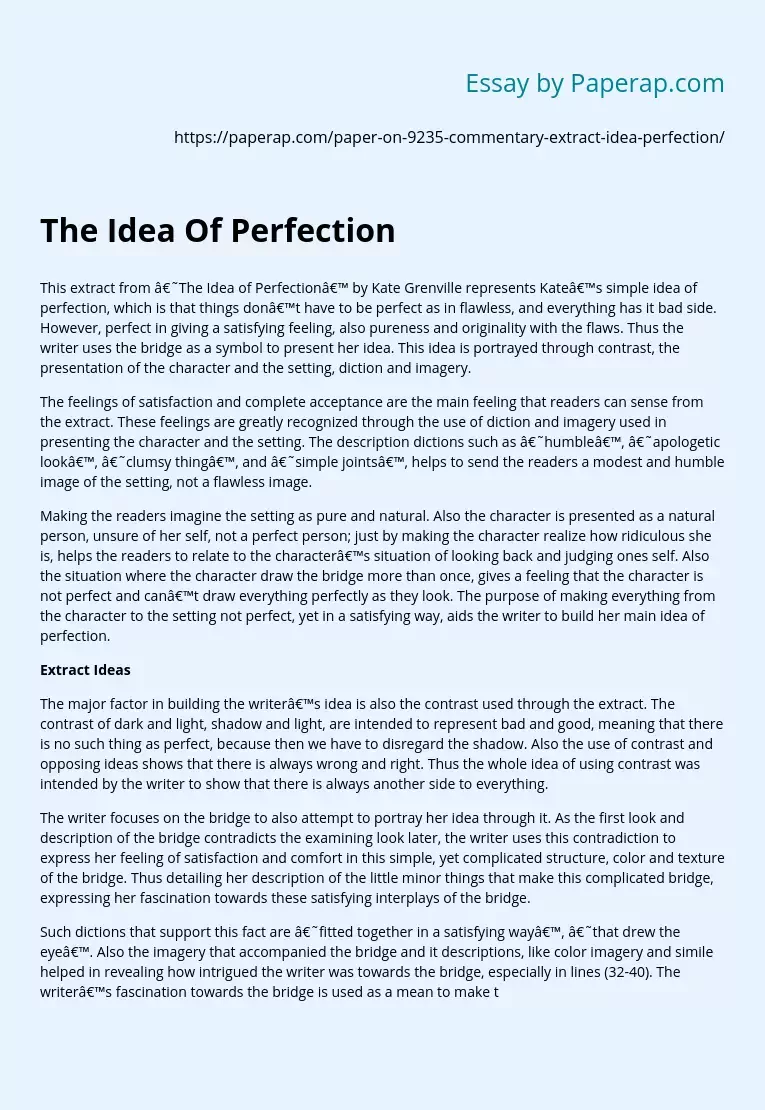The Idea Of Perfection
This extract from ‘The Idea of Perfection’ by Kate Grenville represents Kate’s simple idea of perfection, which is that things don’t have to be perfect as in flawless, and everything has it bad side. However, perfect in giving a satisfying feeling, also pureness and originality with the flaws. Thus the writer uses the bridge as a symbol to present her idea. This idea is portrayed through contrast, the presentation of the character and the setting, diction and imagery.
The feelings of satisfaction and complete acceptance are the main feeling that readers can sense from the extract.
These feelings are greatly recognized through the use of diction and imagery used in presenting the character and the setting. The description dictions such as ‘humble’, ‘apologetic look’, ‘clumsy thing’, and ‘simple joints’, helps to send the readers a modest and humble image of the setting, not a flawless image.
Making the readers imagine the setting as pure and natural. Also the character is presented as a natural person, unsure of her self, not a perfect person; just by making the character realize how ridiculous she is, helps the readers to relate to the character’s situation of looking back and judging ones self.
Also the situation where the character draw the bridge more than once, gives a feeling that the character is not perfect and can’t draw everything perfectly as they look. The purpose of making everything from the character to the setting not perfect, yet in a satisfying way, aids the writer to build her main idea of perfection.
Extract Ideas
The major factor in building the writer’s idea is also the contrast used through the extract. The contrast of dark and light, shadow and light, are intended to represent bad and good, meaning that there is no such thing as perfect, because then we have to disregard the shadow. Also the use of contrast and opposing ideas shows that there is always wrong and right. Thus the whole idea of using contrast was intended by the writer to show that there is always another side to everything.
The writer focuses on the bridge to also attempt to portray her idea through it. As the first look and description of the bridge contradicts the examining look later, the writer uses this contradiction to express her feeling of satisfaction and comfort in this simple, yet complicated structure, color and texture of the bridge. Thus detailing her description of the little minor things that make this complicated bridge, expressing her fascination towards these satisfying interplays of the bridge.
Such dictions that support this fact are ‘fitted together in a satisfying way’, ‘that drew the eye’. Also the imagery that accompanied the bridge and it descriptions, like color imagery and simile helped in revealing how intrigued the writer was towards the bridge, especially in lines (32-40). The writer’s fascination towards the bridge is used as a mean to make the readers relate to a moment of realization where even though things are flawed, they can still generate a simple feeling of satisfaction and acceptance.
The extract is purely just an idea of the writer’s, that introduces a new look at perfection, flawed perfection. Flawed perfection is what humans are all about; we are perfectly humans with our flaws; and this flawed perfection gives us acceptance to who we are, makes us natural and human. The writer could just simply relate this idea to everyday life things; however, it can’t be detached from the idea that flawed perfection is what keeps us intrigued, interesting and natural. Thus the writer uses the fact that flawed perfection in intriguing, yet natural, in other words complicated, yet simple; to build her novel.
The Idea Of Perfection. (2019, Dec 05). Retrieved from https://paperap.com/paper-on-9235-commentary-extract-idea-perfection/

